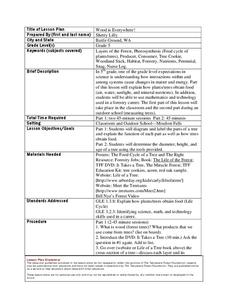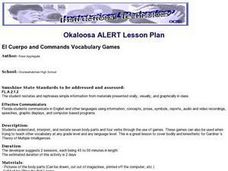Curated OER
Dictionary Details
This clever activity has students practice finding a variety of types of information in a dictionary by playing a "Dictionary Scavenger Hunt" game. Students must use the guide words at the top of a dictionary page, determine what part of...
Curated OER
WOW - Who Or What? (A Six Trait Lesson)
Students locate and select riddles in library books to share, write riddles using template, select appropriate parts of speech to complete riddle template using AlphaSmart, correctly capitalize and punctuate riddle, and illustrate their...
Curated OER
Researching Lesson 4
Students explore a "table of contents." In this book researching lesson, students identify common elements of a "table of "contents" and complete a worksheet with questions about this topic.
Curated OER
Exploring Plants
Pupils examine plants using adiotapes, Internet research, and print media. They name the plant parts and discover their functions. Students create computer-generated pictures of their plants and label the parts. Other activities include...
Curated OER
Wood is Everywhere!
Fifth graders diagram and label the parts of a tree. For this lesson on how trees obtain food, 5th graders diagram and label the parts of a tree, and determine the diameter, height, and age of a tree.
Curated OER
English With Technology
Fourth graders use the smart board and their workbook to complete writing assignments based on parts of speech and sentence structure. In this writing lesson plan, 4th graders write, question, punctuate, and more.
Curated OER
Using the GED Calculator
Students are provided with a a Casio FX-260 to use during a GED test. They may not bring their own but this lesson plan enables them to practice with one before taking the test. This calculator is used to double check work and step by...
Curated OER
Party with Plants
Students watch a video on plant parts and identify the function of plant parts. In this plants lesson plan, students identify the parts of plants they eat and relate it back to the food pyramid and perform math problems as they do this.
Curated OER
Body Language
First graders investigate the three main parts of a plant. In this plant parts lesson, 1st graders explore vocabulary for the topic and read a story about plant parts. Students view a PowerPoint and take a quiz for the topic....
Curated OER
Plant Cycles
Students identify plants parts and their functions. In this plant cycle lesson, students examine parts of plants and how the parts help them survive in its environment. Students use graphic organizers, the internet, books and...
Curated OER
El Cuerpo and Commands Vocabulary Games
Students study Spanish vocabulary words for body parts, and also study a number of action verbs. They participate in Total Physical Response by responding to teacher given commands. They play a number of games based on the vocabulary.
Curated OER
Exploring Texture In the Garden
Students explore the garden environment. In this garden environment instructional activity, students investigate the needs and parts of a plant. Students discover the differences between fruits and vegetables while creating their own...
Curated OER
Our Land: League Philanthropy Unit
Pupils use the folk singer Woody Guthrie's song 'This Land is Your Land' to learn about the responsibility of every person to take care of each other and the land. In this land preservation lesson, students sing the song, learn...
Curated OER
Seasons of Trees
Learners examine how trees change over time. For this forestry lesson, students read the book The Seasons of Arnold's Apple Tree and choose three trees to observe over a period of time. Learners record observations and seasonal changes...
Curated OER
An Eye on Science
Learners investigate the human eye and its parts. They read and discuss various books about eyes and sight, draw a rough draft of an eye diagram, and create a final draft of their eye diagram including labeled parts using Kid Pix...
Curated OER
N is for Natural State
For any pupils who live in the state of Arkansas, this would be a fabulous educational experience to help them get to know their state better. Through the use of activities in literature, art, mathematics, science, social studies, and...
Baylor College
About Air
Give your class a colorful and tasty representation of the components of the mixture that we call air. Pop a few batches of popcorn in four different colors, one to represent each gas: nitrogen, oxygen, argon, and carbon dioxide. The...
Curated OER
Pride and Prejudice: Concept/Vocabulary Analysis
Clarify the setting, literary themes, and potential vocabulary issues with a concept analysis resource. With thoughtful explanations of many parts of Jane Austen's Pride and Prejudice, the reference sheet will be a great...
Novelinks
The Hobbit: Writing Assignment
As a culminating assignment for a unit study of heroes that uses The Hobbit as the core text, class members engage in a multi-genre writing project.
Scholastic
Perfect Postcards: Illinois
Connect the geography and history of Illinois using an art-centered instructional activity on the railroads. The railroad connected once-distant places, particularly in the Midwest. Using research, class members create postcards of...
Curated OER
Tuesdays with Morrie: Question-Answer Relationships
As part of their study of Mitch Albom's Tuesdays with Morrie, class groups examine passages from the story and respond to a series of QAR questions.
Curated OER
Larva and Adult Antlion Body Parts
Students identify the major body segments of antlions. Through the use of diagram worksheets, students label the various body parts of the antlion. They review the life cycle of antlions from the larva stage to adult. Several activities...
Curated OER
Literature Book: Rat-a-tat-tat
Students explore choral reading. In this oral reading lesson, students listen to the book Rat-a-tat-tat by Jill Eggleton and participate by reading certain parts chorally and adding sound effects with instruments and noise makers.
Curated OER
Trivia Books: Louisiana Purchase Bicentennial Celebration
Students detrmine the importance of point of view. They use a well-known fairy tale to explore how changing the point of view changes the whole story. They generate questions from the text they want answered during the unit and construct...























